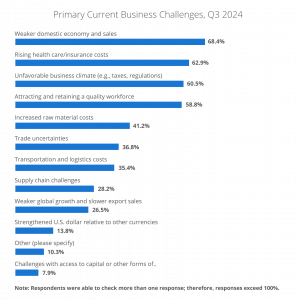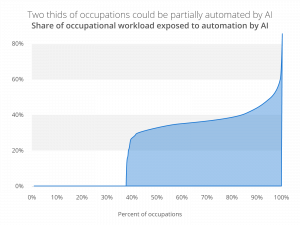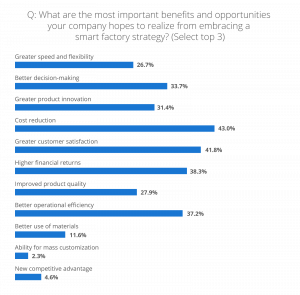Manufacturers today face an increasingly complex operational landscape, with rising raw material costs, shifting market demands, and the need for greater efficiency. In response, businesses are adopting innovative strategies to remain competitive and drive profitability. According to KPMG, 74% of Manufacturing CEO’s named economic uncertainty as one of their top challenges heading into 2025.
Automation has become a cornerstone of this transformation, enabling manufacturers to optimize costs, streamline operations, and unlock data-driven insights for better decision-making. This blog explores the pressing challenges in the manufacturing sector and illustrates how automation offers scalable, flexible solutions. We’ll also highlight a success story where automation of accounts payable processes delivered measurable cost savings and operational improvements, showcasing its pivotal role in fostering resilience and growth.
What Economic Challenges are Manufacturers Facing?
Rising Raw Material Prices
Rising raw material prices present significant hurdles for manufacturers striving to maintain profitability and operational stability. According to the National Association of Manufacturers (NAM) Q3 2024 Outlook, 41.2% of survey respondents consider “increased raw material costs” to be one of their primary current business challenges.

The increase in costs has been fueled by a combination of global supply chain disruptions and heightened demand. Here are several ways these increasing costs are impacting manufacturers:
- Rising Operational Costs: Increased costs drive up operational expenses, necessitating a re-evaluation of budgeting and financial strategies.
- Profit Margin Pressures: Tighter profit margins restrict investment in innovation and growth opportunities.
- Supply Chain Strain: Higher costs complicate supply chain management, potentially leading to disruptions and inefficiencies.
- Pricing Challenges: A need to adjust product pricing to absorb costs can hinder competitiveness.
- Reduced Investments: Higher material costs curtail investment in technologies and processes that boost efficiency and sustainability.
- Resource Allocation Issues: Escalating costs complicate efficient resource allocation, risking wastage and financial loss.
- Financial Risks: Heightened costs increase financial risks, including potential liquidity challenges and the need for additional financing.
- Strategic Adjustments: Companies may prioritize short-term cost management over long-term strategic planning, affecting their market position.
Understanding these impacts enables manufacturers to better prepare for and mitigate the adverse effects of rising raw material costs.
Inflation
Inflation presents a persistent challenge for the manufacturing sector, affecting everything from labor costs to energy expenses. Despite consumer inflation showing signs of decline, the knock-on effect to business costs persist. Forbes report labor, energy and raw materials to be the biggest costs for businesses in 2025.
Here’s how these costs are affecting manufacturers:
- Rising Labor Costs: Inflation leads to higher wages as workers seek increased pay to match living costs, straining manufacturers’ budgets.
- Volatile Energy Expenses: Inflationary periods make energy costs more volatile and expensive, raising production costs and affecting pricing strategies.
- Raw Material Price Increases: Inflation drives up raw material costs, narrowing profit margins and forcing manufacturers to find ways to absorb or transfer costs.
- Eroded Purchasing Power: Inflation reduces consumer purchasing power, potentially decreasing demand and impacting sales and profits.
- Increased Operational Expenses: Rising overall costs compel manufacturers to rethink financial strategies and improve operational efficiency.
- Budget Challenges: Unpredictable cost increases complicate budgeting, leading to financial uncertainties and requiring contingency plans.
These factors necessitate strategic adjustments to maintain competitiveness. It is essential for manufacturers to focus on agile financial planning, resource management, and exploring other innovative strategies to sustain economic health amidst inflationary pressures.
Demand Uncertainty
Unpredictable demand is a formidable challenge in the manufacturing sector, disrupting production schedules and inventory management. This volatility can lead to either surplus stock or shortages, both of which carry financial risks. This volatility presents multiple hurdles for manufacturers:
- Surplus and Shortages: Inconsistent demand can cause surplus stock, increasing storage costs, or shortages, harming customer relationships and resulting in lost sales.
- Financial Pressures: Managing unsold inventory or unmet demand strains profit margins and operational budgets.
- Resource Planning Strain: Demand fluctuations complicate resource allocation, hindering effective labor and material deployment.
- Supply Chain Inefficiencies: Inaccurate demand forecasting can lead to inefficiencies and bottlenecks in the supply chain.
- Schedule Disruptions: Unpredictable demand necessitates frequent production schedule adjustments, affecting productivity and efficiency.
These challenges hinder manufacturers’ ability to maintain stability, requiring them to find innovative ways to adapt to this unpredictable business environment.
With manufacturers grappling with the pressures of escalating raw material costs, inflation, and unpredictable demand, a strategic pivot towards automation is required. By doing so, manufacturers can enhance efficiency, optimize resources, forecast demand and flexibly scale operations in order to maintain competitiveness and ensure economic resilience.
How Does Automation Increase Efficiency in Manufacturing?
Streamlining Manufacturing and Optimizing Resource Allocation with Automation
In today’s competitive manufacturing landscape, automation is proving to be indispensable in both streamlining production processes and optimizing resource allocation. A recent article by Forbes refers to automation as excelling at repetitive tasks and transforming business operations. In this article, they also quote a recent Goldman Sachs report that states that two-thirds of occupations could be partially automated by AI.

By integrating advanced automated systems powered by Artificial Intelligence (AI), manufacturers are able to reduce waste, enhance efficiency, and maintain consistent product quality while also ensuring effective material and labor utilization.
Here are 6 ways in which automation enables manufacturers to achieve these things:
- Minimizing Human Error and Boosting Production Speed: Automation of repetitive tasks reduces human error while speeding up production and ensuring consistent product quality.
- Real-Time Monitoring and Adaptability: Advanced systems offer real-time tracking, identifying inefficiencies, and suggesting improvements to help manufacturers adapt quickly and maintain cost-effective operations.
- Integration across Production Stages: Automation connects various production stages, from supply chain management to final assembly, creating a unified and responsive manufacturing process.
- Data-Driven Resource Allocation: Automated tools provide accurate insights into resource use, enabling more strategic distribution of materials and labor to enhance efficiency and minimize waste.
- Predictive Maintenance: Automation supports predictive maintenance by addressing machinery issues early, reducing downtime, and optimizing labor use.
- Supply Chain Synchronization: Automation aligns supply chain activities with production needs, reducing excess inventory and minimizing stockout risks, leading to cost savings.
By investing in automation, manufacturers can significantly lower operational costs and boost productivity. Furthermore, automation allows them to maintain competitive pricing and strengthen their market position ensuring sustainability and growth.
Utilizing Predictive Analytics for Better Forecasting
Predictive analytics is transforming the manufacturing sector by providing powerful forecasting capabilities through the use of automation tools. This advanced approach helps manufacturers analyze market trends and dynamically adjust strategies to address economic challenges effectively.
According to IBM, predictive analytics helps manufacturers understand the drivers behind customer buying patterns to anticipate which products customers want, how many they want and when. By leveraging automated systems and advanced data analytics, companies can gain valuable insights that drive smarter decision-making and enhance their competitive position.
Leveraging Predictive Analytics for Market Trends and Strategy Adjustments
Predictive analytics plays a crucial role in empowering manufacturers to anticipate market changes, optimize operations, and maintain competitiveness. By harnessing advanced data analytics, companies can make informed decisions and efficiently respond to economic uncertainties. Here are 8 ways in which predictive analytics enables manufacturers to analyze market trends and adjust strategies dynamically:
- Continuous Real-Time Tracking: Automated systems monitor large volumes of market data, ensuring access to up-to-date information for immediate decision-making.
- Advanced Algorithm Application: Sophisticated algorithms interpret data trends and projections, highlighting emerging trends and shifts in consumer behavior.
- Demand Shift Anticipation: By predicting changes in consumer demand, companies can adjust production and supply plans accordingly.
- Efficient Resource Allocation: Data-driven insights facilitate the strategic distribution of resources, minimizing waste and maximizing efficiency.
- Optimized Production Scheduling: Align production timelines with demand forecasts to streamline operations and enhance productivity.
- Inventory and Supply Chain Alignment: Predictive analytics helps align inventory levels with anticipated demand and identify potential supply chain risks early.
- Proactive Operational Adjustments: Manufacturers can adjust operational procedures in anticipation of market fluctuations, boosting resilience and flexibility.
- Enhanced Financial Performance: By maximizing profitability through informed, timely strategic decisions, companies sustain better financial health.
These capabilities underscore the transformative potential of predictive analytics within the manufacturing sector, allowing for dynamic strategy adjustments that foster growth and adaptability.
How Does Automation Help Achieve Manufacturing Flexibility?
In the face of unpredictable production demands, manufacturers are increasingly turning to automation for its unparalleled ability to provide adaptability and scalability. This is something reported by the Manufacturing Leadership Council, where 26.7% of manufacturing leaders named “greater speed and flexibility” as one of the most important benefits of an automated factory.

Automation empowers manufacturers to efficiently manage production fluctuations, offering robust solutions that streamline operations while ensuring resilience against market variability.
Here are 6 key ways manufacturers use automation to adapt and thrive:
- Adapting to Demand Fluctuations: Automated systems efficiently adjust to changes in production needs, ensuring optimal levels without incurring excessive costs.
- Rapid Reprogramming and Retooling: Automation enables quick reconfiguration of machinery for seamless product line transitions, reducing downtime and enhancing productivity.
- Supply Chain Alignment: Automation synchronizes the supply chain, ensuring timely raw material availability, minimizing inventory costs, and avoiding stockouts.
- Efficient Resource Utilization: Automated systems enhance resource utilization, cutting costs while maintaining efficiency and operational resilience.
- Fostering Innovation: Automation supports experimentation with new products with minimal disruption, promoting continuous improvement.
- Agile Risk Management: Manufacturers can rapidly pivot strategies in response to economic shifts or disruptions, improving risk management.
Through these capabilities and benefits, automation not only supports sustainable growth but also opens up opportunities for manufacturers to innovate and capitalize on new market trends.
Accounts Payable Automation: The Key to Navigating Economic Uncertainty
The Story of How Logitech Overcame Financial and Operational Challenges
Logitech, the Swiss multinational manufacturer of computer peripherals and software, was grappling with the rising costs and economic uncertainties that put a strain on their financial and operational efficiency. In a climate where cost control and strategic agility were crucial, Logitech faced multiple challenges with their accounts payable processes that impeded their ability to maintain fluid financial operations. These included:
- Multiple Manual Touchpoints: The accounts payable process relied on numerous manual steps, increasing error probability and causing delays.
- Invoice-Purchase Order Matching: Matching invoices to purchase orders was cumbersome, leading to frequent errors and inefficiencies.
- Time-Consuming Processes: Manual methods extended processing times and delayed payments.
- Limited Visibility: Insufficient insight into financial transactions hindered effective decision-making.
- Integration Challenges: Difficulty integrating with the ERP system resulted in data silos and workflow disruptions.
- Complex Multiregional Handling: Processing invoices from various regions with different languages, currencies, and tax rules was complex and prone to mistakes.
To address these issues, Logitech partnered with SoftCo, leveraging our AP automation technology to transform their accounts payable function:
- Automated Data Extraction and Matching: SoftCo’s solution automatically extracts invoice information and matches it with Purchase Order and Goods Receipt data, eliminating errors.
- Seamless ERP Integration: Integrated with Logitech’s ERP, the platform ensures smooth data flow across systems.
- Multilingual and Multijurisdictional Handling: The solution handles invoices for Logitech’s European, North America, and Asian divisions, supporting multiple languages and jurisdictions.
- Real-Time Financial Insights: Improved visibility into transactions helps Logitech make informed decisions and enhance budgeting.
- Efficiency and Speed: Automation minimizes manual tasks, speeding up invoice processing and improving cash flow through timely payments.
Since implementing SoftCoAP, Logitech have achieved an 83% straight through processing rate of their purchase order invoices. This has translated into a number of significant benefits:
- Cost Savings: Reduction in manual processing and errors has translated into substantial cost savings.
- Operational Efficiency: Streamlined processes have decreased processing times and improved productivity.
- Improved Cash Flow: Timely invoice processing and reduced delays support better cash flow management.
- Enhanced Supplier Relationships: Faster processing and timely payments have strengthened relationships with suppliers.
- Strategic Financial Management: Logitech now have 100% visibility and control over financial transactions, supporting strategic decision-making and planning.
Embracing automation allows manufacturers to navigate economic volatility by enhancing efficiency, forecasting capabilities, and operational flexibility. Through strategic automation, manufacturers are realizing the potential for significant cost savings and improved resilience, ensuring sustained growth in a dynamic market environment.


